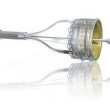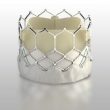Transcatheter aortic valve replacement (TAVR) using the ACURATE neo device depends, largely, on correct patient selection and appropriate oversizing. The individual anatomy of each patient, namely periannular and aortic root calcification, must be taken into account. The ACURATE neo valve (Symetis/Boston, Ecublens, Switzerland) is a new-generation self-expanding valve characterized by a stent design shaped as an X<a href="https://solaci.org/en/2018/06/15/the-largest-registry-on-the-acurate-neo-valve/" title="Read more" >...</a>
EuroPCR 2018 | NOTION: Good TAVR Durability Compared with Surgically-Implanted Valve in Low-Risk Patients
Several studies are defining the role of transcatheter aortic valve replacement (TAVR) in patients with low surgical risk. One of the main concerns for this population, whose life expectancy is much longer, has to do with TAVR durability compared with a surgically-implanted biological valves. The Nordic Aortic Valve Intervention (NOTION) trial was the first study<a href="https://solaci.org/en/2018/05/29/europcr-2018-notion-good-tavr-durability-compared-with-surgically-implanted-valve-in-low-risk-patients/" title="Read more" >...</a>
Bicuspid Valves Do Not Increase Mortality in TAVR
The frequency of bicuspid aortic valves (BcAV) are around 1%, but in 60+ patients it is associated to severe aortic stenosis. Even though surgery is the standard treatment, TAVR is the “off label” indication in high risk patients. BcAV presents differences with tricuspids given that it is more elliptic, has asymmetric calcification and more<a href="https://solaci.org/en/2018/05/02/bicuspid-valves-do-not-increase-mortality-in-tavr/" title="Read more" >...</a>
Which Low-Flow, Low-Gradient Patients Benefit from Valve Replacement?
A mean gradient ≥40 mmHg, an aortic valve area ≤1 cm², or a combination of both, during dobutamine stress echocardiography, correctly qualifies as severe aortic stenosis in about half of all patients. The other half consists in cases of pseudo-severe aortic stenosis. In turn, a projected aortic valve area ≤1 cm² is a much better indicator than the<a href="https://solaci.org/en/2018/04/09/which-low-flow-low-gradient-patients-benefit-from-valve-replacement/" title="Read more" >...</a>
Transcatheter Mitral Valve Replacement Devices Multiply
The Transcatheter mitral valve replacement has been established as gold standard for patients with intermediate or high risk severe aortic stenosis. The supporting evidence was initially gathered with one or two safe and effective devices that worked really well, so that later on prosthetic valves multiplied, for competing companies wanted their share of the market. However,<a href="https://solaci.org/en/2018/02/12/transcatheter-mitral-valve-replacement-devices-multiply/" title="Read more" >...</a>
Lotus Valve in Real Life Patients: the near total lack of leaks is its greatest strength
Even though the incidence of complications in transcatheter aortic valve replacement (TAVR) have significantly decreased, there is one in particular that remains a concern since, when mild, it is associated to increased events rate. This complication is prosthetic paravalvular leak , which happens between the native annulus and the stent. The Lotus valve, completely repositionable, uses a<a href="https://solaci.org/en/2018/01/23/lotus-valve-in-real-life-patients-the-near-total-lack-of-leaks-is-its-greatest-strength/" title="Read more" >...</a>
TAVR in Pure Aortic Regurgitation: New Devices, New Outcomes
Pure aortic regurgitation has historically been considered a contraindication for transcatheter aortic valve replacement (TAVR) due to the absence of calcification and subsequent device anchoring problems it poses. Initial reports on first-generation self-expanding valves for the treatment of pure regurgitation were somewhat discouraging, but devices evolved, adding repositioning capacity, different external skirts (pericardial, PET, urethane,<a href="https://solaci.org/en/2017/12/26/tavr-in-pure-aortic-regurgitation-new-devices-new-outcomes/" title="Read more" >...</a>
TAVR in Patients with Pure vs. Mixed Aortic Stenosis: Benefits and Evolution
Courtesy of Dr. Carlos Fava. Transcatheter aortic valve replacement (TAVR) has been proven to reduce mortality and improve the quality of life of patients with pure severe aortic stenosis (PAS). However, there is a significant number of patients who experience mixed aortic stenosis associated with moderate/severe aortic regurgitation (MAS). These subjects were excluded from the PARTNER<a href="https://solaci.org/en/2017/12/12/tavr-in-patients-with-pure-vs-mixed-aortic-stenosis-benefits-and-evolution/" title="Read more" >...</a>
Small Aortic Annulus: What Valve Should We choose?
Courtesy of Dr. Carlos Fava Surgical aortic valve replacement in a small annulus (<400 mm2) is associated with shorter duration, higher valve deterioration and patient prosthesis mismatch (PPM). They present a negative impact as regards duration and evolution. TAVR might be an option, with superior hemodynamic outcome and lower PPM. Read also: “Patients and Healthcare<a href="https://solaci.org/en/2017/12/06/small-aortic-annulus-what-valve-should-we-choose/" title="Read more" >...</a>
New Self-Expanding Valve Measures Up Against Sapien 3
Both balloon-expandable and self-expanding valves have been tested in randomized studies, with excellent outcomes. While both technologies have advantages, the chance to reposition or re-steer the sheath is only offered by self-expanding valves, which also adjust better to patient anatomy. The CHOICE trial, published in 2014 in JAMA, was one of the few randomized studies<a href="https://solaci.org/en/2017/11/24/new-self-expanding-valve-measures-up-against-sapien-3/" title="Read more" >...</a>









